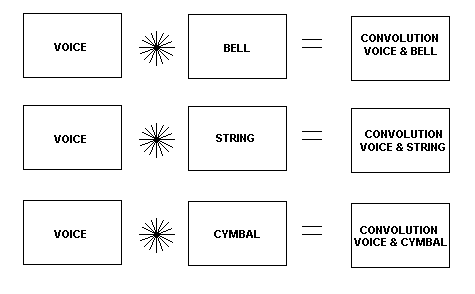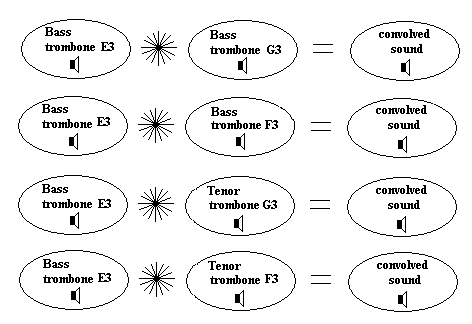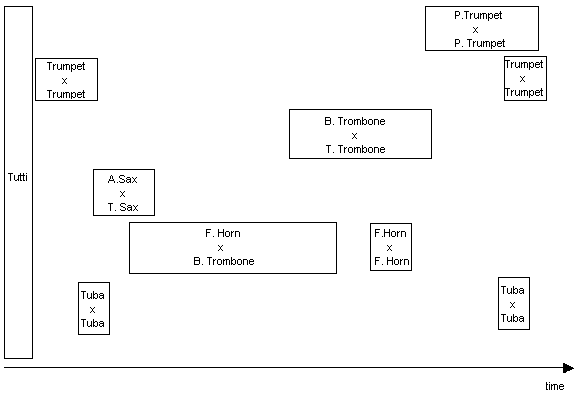|
JMM 1, Fall 2003, section 4 4.1. Introduction While transforming sounds for an electroacoustic piece of music in order to combine sonorities of different brass instruments, I started using convolution as a blending tool for timbres. The purpose was to combine timbres of musical instruments that would lead to new sonorities and still be related to the original sounds. This article documents this creative process; its goal has been to describe some of the possible uses of convolution in order to make a fusion or blending of sounds of musical instruments for musical purposes. Technically speaking, convolution is a mathematical operation that provides a way of multiplying two arrays of numbers. When applied to digital sound manipulations, it means multiplying every sample in one wave or impulse by the samples that are contained within another waveform. In other words, using convolution one can employ one waveform to "model" or "shape" the sound of another waveform.
4.3. Blending of Ensemble Timbres When listening to simultaneous instrumental sounds, one perceives either several individual pitches in harmonic relationship as a musical chord or a fused timbre with pitch (Erickson, 1975, pp.18-57). According to Erickson fused ensemble timbres fulfil the following conditions:
Some elements facilitating fusion of sounds in an ensemble are: simultaneity of events, duration of sounds, attacks and decays, dynamic balance of voices, dissonance, harmonics and others. 4.4. Blending of Isolated Tones with the Use of Convolution Inspired by the idea of perceptual fusion of instrumental timbres in an ensemble, I used convolution to integrate timbres of different sounds of brass instruments for musical purposes. As a starting point, different isolated tones of diverse brass instruments were employed to build pairs of convolved timbres to be used in the piece. The instruments chosen for the combinations were: French horn, bass and tenor trombone, tenor and alto saxophones, trumpet and piccolo trumpet. In most of the cases the instruments were convolved in pairs, according to similarities in timbre and in some cases to contrasting sonorities. Two different categories were used for convolutions of sounds: convolved pairs of sounds from the same instrument and convolved pairs of sounds from different instruments.
4.5. Constellations 1: Organised Blocks of Convolved Brass Sounds Using sounds created with convolution I started to create levels of timbre blending for musical purposes. Pairs of sounds were associated according to similarities and contrasts in sonority, maintaining the dynamic evolution of the original brass instruments. For this purpose different blocks of convolved pairs of sounds were created and associated as overlapping blocks of sound events in time. Figure 3 shows the overall structure of the piece Constellations 1 that can be listened to by clicking the figure. The idea behind this structure was to create a type of continuum with similarities and contrasts in convolved timbres.
Concerning the use of convolution as a means of timbre fusion in the creative process, it can be concluded that: 1. Most of the elements facilitating blending of ensemble timbres described by Erickson are also valid when using convolution as a creative tool to fuse brass timbres. 2. Convolution works most effectively in blending timbres of static tonal continuous sounds, such as the isolated tones of brass instruments used in the piece shown as an example. The use of more complex sound material, less continuous in amplitude and less harmonic in the spectrum, needs to be treated with special care in order to obtain timbre blending. 3. The pitch and tonal register of sounds proved to be determinant for the blending of tones of brass instruments with convolution. As shown by Erickson, the dissonance clearly helps the blending of tonal sounds. As to ensemble timbres, the more harmonic or consonant the relationships of the tones convolved, the more difficult it was to create a fused sound due to the fact that the sound perceived was a tonal interval or chord that could easily be related to one or both of the instruments of the tones. 4. Special care should be taken with the amplitudes of the original sounds before convolution. These amplitudes will have consequences for the convolved sound. For an optimal blending of sounds with convolution, a previous amplitude normalization of the tones is recommended. Some characteristics of the combined sounds can be affected in the convolution process, mostly in the attack and decay of the sounds. 5. Convolution is a useful tool that can be used to blend sounds and create interesting types of orchestrations of instrumental sounds. The potential for its use depends to a large extent on the types of sounds and the way these sounds are combined.
To refer to this article: click in the target section |
||||||||||
|
|||||||||||



